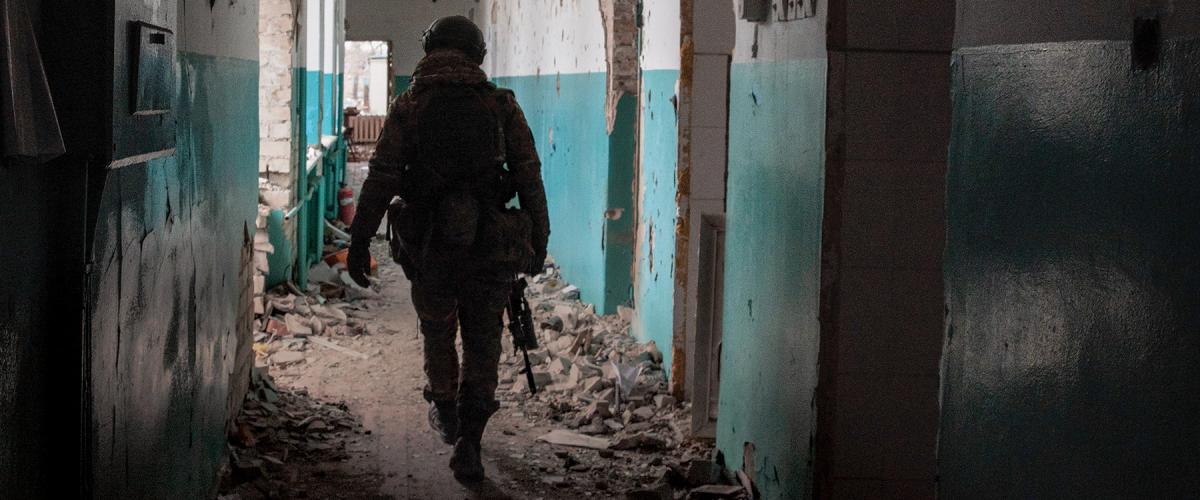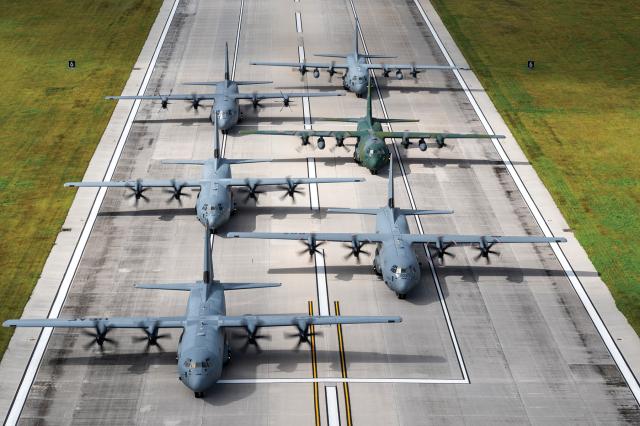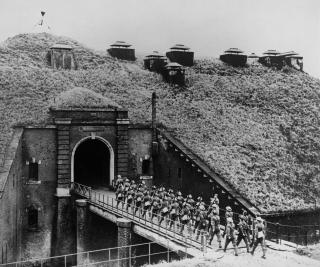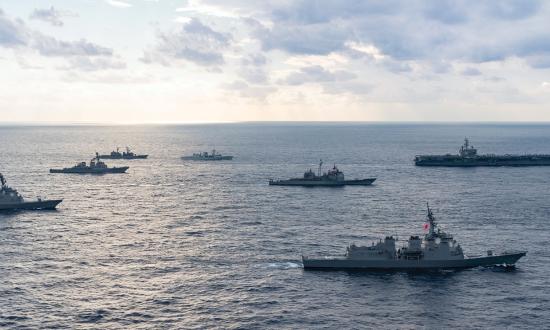Today, three ideas seem to enjoy widespread support: The character of war is changing, competition with China represents a generational challenge, and deterring wars is at least as important as winning them. The ongoing war in Ukraine has shown that the modern battlefield is meaningfully different from past ones; China is growing increasingly coercive and bellicose in pursuing its authoritarian goals and hegemonic ambitions; and a recent study concluded a Pyrrhic U.S. victory is the most likely outcome of a U.S.–China conflict over Taiwan.1 It is no surprise, then, that deterrence is at the core of many U.S. strategic documents.
But Russia’s 2022 invasion of Ukraine has showcased the limits of deterrence and demonstrated that conventional war is not dead—at least not entirely: Nuclear-armed countries still invade their neighbors, states can still mobilize people and resources in the name of national interests, and conflict is still a bloody affair. Rather than a deviation from the norm, then, the war in Ukraine may instead portend a return to the norm. Therefore, while deterrence must endure as a core tenet of U.S. strategy, the United States must ensure its efforts to deter also generate warfighting advantage. Put simply, capabilities that disproportionately favor bark over bite are decreasingly useful in today’s competition.2
The Indo-Pacific’s expansive oceans dominate today’s geostrategic competition and make maritime superiority vital to securing U.S. national interests. Thus, to navigate this generational challenge, the United States must maintain maritime superiority. Doing so involves recognizing the changing character of war, supporting integrated deterrence, and ensuring significant warfighting advantage should deterrence fail.
Using history as a guide, the United States can chart the course between deterrence and warfighting advantage. France’s failure to learn from Nazi Germany’s 1939 invasion of Poland underscores the importance of quickly applying lessons from the ongoing conflict in Ukraine. Similarly, the United States’ failure to protect Pearl Harbor demonstrates the potential consequences of failing to shore up Guam’s defenses today. Lessons from Ukraine can prevent that island from becoming the next Pearl Harbor.
In contrast, the U.S. Navy’s process for improving carrier aviation during the interwar period offers an affirmative tale that provides a framework for using Ukraine’s battlefield lessons to quickly improve U.S. maritime capabilities today.
Ukraine as Poland
Roughly a decade before World War II, France began constructing the infamous Maginot Line, which covered most of France’s eastern border with Germany. French forces built this defensive behemoth at immense cost.3 The result might have been one of the greatest deterrents ever made—had it not been built for the tactics of the previous war. Beginning on 10 May 1940, the Nazi Wehrmacht steamrolled across Western Europe, achieving in just six weeks what had eluded the German Empire for all of World War I. Blitzkrieg—as the German Army’s concept for mobile, combined arms came to be known—was an astounding demonstration of Nazi Germany’s holistic approach to operationalizing the interwar period’s technological changes.4 The character of war had changed, and Western Europe was caught flat-footed.
Blitzkrieg’s effectiveness in May 1940 should not have produced the shock and surprise it did. Just eight months prior, elements of the concept had been on clear display when Germany invaded Poland in September 1939. While the concept did change some between September and May, “operationally the effects of German military powers were fully visible.”5
The French inability to adapt was not the product of ignorance, however. Multiple senior leaders, including then-Colonel Charles de Gaulle, made observations about the Polish campaign, but little meaningful change filtered down to the operational or tactical levels.6 Despite clear examples demonstrating how war’s character had changed, France proved intractably rigid behind the Maginot Line.7 Had the French, Belgians, Dutch, and British learned and applied the lessons of 1939, they might well have blunted the German invasion.
The United States today possesses some of the most powerful military capabilities in the world. For example, a U.S. Navy carrier strike group generally includes at least one guided-missile cruiser and a destroyer squadron organized around a nuclear-powered aircraft carrier—a floating city that brings to bear thousands of people and an entire carrier air wing. A single carrier strike group can project more power than many whole militaries—and the Navy maintains nine such formations.
Yet, aircraft carriers and large strike group formations are newly vulnerable in concerning ways; Ukraine’s sinking of the Russian cruiser Moskva dramatically underscores this point.
On 14 April 2022, two Neptune antiship cruise missiles slammed into the Slava-class cruiser, causing a large fire and possible secondary explosions. The Moskva sank shortly thereafter while under tow.8 The asymmetric advantage of long-range precision fires over traditional platforms has been a talking point in Washington for decades, just as Western Europeans recognized Nazi Germany’s interwar innovations.9 But when the flagship of Russia’s Black Sea Fleet settled on the sea floor, the danger was again brought home. U.S. carrier strike groups are immensely superior to Russian vessels, but the antiship missile threat inside the People’s Liberation Army’s weapons engagement zone is immensely greater than Ukraine’s. Despite any lessons from the Moskva episode, the U.S. Navy continues construction of its two forthcoming $13 billion aircraft carriers, seemingly unchanged.10 The United States appears concerningly rigid behind its military-industrial-complex-like Maginot Line.
The sinking of the Moskva is only one example of the myriad observations emerging from Ukraine. Consider two others. First, the homeland is no longer a sanctuary.11 The United States must harden its installations and infrastructure against threats of cyberattacks and long-range precision fires that can target specific, dual-use capabilities. Second, the efficacy of prolific, asymmetric weapon systems is undeniable. Examples of such systems are unmanned assets, such as small unmanned aerial systems and unmanned surface vehicles; precision-guided munitions, such as High-Mobility Artillery Rocket Systems; and defensive systems, such as Javelin antitank weapons. The United States must recognize these changes and learn from them.
Guam as Pearl Harbor
Concerns over Pearl Harbor’s safety circulated as early as 1924, when Brigadier General William “Billy” Mitchell emphasized Pearl Harbor’s vulnerability to Japanese air attack.
When war in the Pacific loomed, multiple U.S. intelligence sources warned of an impending attack on Pearl Harbor, and discussions of the base’s vulnerability reached the highest levels of the U.S. government.12 In late 1940, the commander of the U.S. Pacific Fleet, Admiral James O. Richardson, met with President Franklin D. Roosevelt to express his concern over Hawaii’s vulnerability and advocate for moving his fleet from Pearl Harbor. Following the heated conversation, Roosevelt’s Chief of Staff, Admiral William D. Leahy, sided with Richardson. Instead of heeding this warning or taking action to protect Pearl Harbor, Roosevelt fired Richardson.13
Despite intelligence warnings and collective recognition of Pearl Harbor’s vulnerability, catastrophe arrived on December 7, 1941. Japanese carrier-based planes sank 4 U.S. Navy battleships and damaged 4 more. They also damaged 3 light cruisers, 3 destroyers, and 159 aircraft. Nearly 200 aircraft were destroyed, 2,335 people were killed, and another 1,143 were wounded.14 The attack is remembered as having galvanized U.S. commitment to fighting World War II; however, its intent was to prevent the United States from interfering in Japan’s regional affairs. Viewed in that light, the tragedy of Pearl Harbor demonstrates how deadly miscalculations can be for all sides in great power conflicts.
Much like Pearl Harbor in the 1920s and 1930s, Guam is at the center of discussions about vulnerabilities and threats. It has been deemed the location “where America’s next war may begin,” because China “makes no secret that Guam is in its crosshairs.” Indeed, China has nicknamed the DF-26 ballistic missile the “Guam killer.”15 Furthermore, Guam’s infrastructure has been a target of Chinese cyber espionage, raising concerns about its integrity.16 Examples such as these show that Guam may face challenges similar to those of Ukraine—where Russian missiles have repeatedly struck Ukraine’s power grid.17 These kinetic strikes on Ukraine’s power grid join a long history of Russian cyberattacks on Ukraine’s infrastructure that has damaged as much as 40 percent of the grid.18 But the lessons of these events are more complex than they first appear.
Despite repeated, complex attacks on Ukraine’s infrastructure, only 40 percent of it was crippled. It is unlikely, then, that the long-feared “cyber Pearl Harbor” will occur on its own. Instead, Russia’s actions in Ukraine show that marrying precision-guided weapons with cyberattacks produces a new, combined threat. Such an approach could be particularly damaging on an island where there is less redundancy than in continental infrastructure. Nevertheless, the lesson of Russia’s actions in Ukraine is that the United States needs to be able to confront these challenges to locations such as Guam—and continue operating in the face of them.
To achieve this state, the United States must invest in both kinetic and nonkinetic defenses commensurate with the kinds of threats the Ukraine war is illuminating. With China possessing “Guam killers” and cyber actors conducting espionage in vital networks, swift investment is the only sure way to prevent Guam from becoming the next Pearl Harbor.
Asymmetry as Aviation
By the end of World War I, carrier aviation’s great promise was coming into focus. The British Royal Navy seized early opportunities afforded by this new technology, such as naval gunfire spotting and projecting power ashore, and demonstrated them to great effect.19 But despite carrier aviation’s early successes, there was still much to learn about its operating procedures, concepts of employment, and true potential. Over the following two decades, the U.S. Navy leapfrogged the British as the leader in carrier aviation, advancing its program in ways that generated notable success early in World War II.20 The process by which the U.S. Navy achieved these dramatic results is a paragon of peacetime innovation. As such, it offers a framework for incorporating modern technologies that are changing the character of war.
Barry Watts and Williamson Murray propose four core elements that drove U.S. carrier aviation’s process for interwar innovation, which can be distilled further into two themes: sustained advocacy and effective feedback loops.21
First, the establishment in 1921 of the Bureau of Aeronautics (BuAer) strengthened naval aviation’s position in the Department of the Navy. This was accomplished by consolidating oversight of naval aviation development by ten disparate entities into a single organization while professionalizing naval aviation by making it appealing to the U.S. Navy’s best and brightest.
Second, an ad hoc process created a feedback loop between speculative wargaming and technical experimentation. Early on, that process helped determine that an aircraft carrier’s metric of effectiveness would be the number of aircraft it could put in the air. Whereas past naval engagements involved streams of fire, carrier engagements would involve waves of aircraft, with the one who massed air power first gaining a significant advantage. This realization emphasized the importance of launch and recovery operations, which drove experimentation, informed requirements, and further refined wargames of the future. In the end, the Navy produced carriers and aircraft that lent themselves to generating massive aircraft formations with minimal turnaround times. Without such innovations, the probable outcome of the Pacific war is dubious at best.22
As during the interwar period, technology is changing the character of war and evolving rapidly, and conventional militaries are struggling to respond. From the sinking of the Moskva to the widespread use of unmanned vehicles, loitering munitions, and precision fires, Ukrainian forces are demonstrating the advantages of small, agile, hard-to-target forces armed with asymmetric weapon systems. This dynamic is reshaping the battlefield.
Traditional maritime power projection within the weapons engagement zones of these capabilities—in what Robert Work describes as “the precision-strike regime” with its near-zero-miss accuracy—puts large, high-cost platforms such as aircraft carriers at great risk.23 In a kinetic conflict, that traditional approach could lead to both high casualties and accelerated escalation on all sides. Similar to Ukrainian tactics—such as hit-and-runs against Russian armor with Javelin missiles—smaller, distributed forces employing prolific, asymmetric weapon systems are difficult targets, and still extremely lethal.
This asymmetric approach is a core tenet of Force Design 2030—the Marine Corps’ response to the most recent, significant changes in modern warfare the United States must be prepared to confront. The service’s new force structure will eventually see three Marine littoral regiments composed of just such “stand-in” forces, well-equipped with precision fires, unmanned aerial systems, and resilient command-and-control networks for asymmetric lethality.24 In retired Commandant General David Berger’s words, “Success will be defined in terms of finding the smallest, lowest signature options that yield the maximum operational utility.”25
Similarly, Chief of Naval Operations Admiral Lisa Franchetti recently stressed “thinking differently” about the role of technology “as the character of war changes.”26 In that vein, the Navy is working to increase the number of both manned and unmanned assets in its force, producing a “hybrid” navy comprising an “ecosystem” of capabilities. Ultimately, this approach seeks to leverage emerging, disruptive technologies to address asymmetric threats and create warfighting advantage.
The Navy and Marine Corps recognize the changes on display, but it remains to be seen whether they can create a vision-experimentation-refinement feedback loop. If so, they will be able to employ the undeniable advantages offered by prolific, asymmetric weapon systems, invest in them further, and be ready to deploy them confidently and effectively—all thanks to their “peacetime” innovation process. In turn, doing so will ideally produce a deterrent effect as well as a warfighting advantage.
Studying the contours of the current conflict in Ukraine and its lessons can help the Sea Services develop their visions of the future, granting them a head start on innovating and adapting.
History as a Teacher
Navigating the tumultuous waters of today’s strategic competition requires an agile, well-informed strategy. The changing character of war and the generational challenge posed by China necessitate as sharp a focus on deterrence as ever. But Russia’s invasion of Ukraine serves as a reminder that deterrence is not foolproof. During competition, deterrence reigns supreme; however, competition is also when preparations are made for conflict if deterrence fails. If the United States focuses on deterrence only, it will miss opportunities—and the window—to prepare for conflict. Therefore, it is imperative that the United States evolve its strategies and capabilities to deter effectively while still ensuring a warfighting advantage.
Historian John Lewis Gaddis argues that those studying the past are often better equipped to confront existential challenges than those merely participating in the present. Historians can interpret the past to inform the present and manage the future—without forfeiting their capacity to assess their actions’ relevance in current circumstances.27 Consequently, the best way to prepare for the complex competition ahead may well be examining the past alongside today’s context to illuminate a way forward. This rearview perspective should not lead the United States into fighting the last war; rather, it should enable it to identify potential dangers, pitfalls, and losses it might encounter in future conflicts, guiding investments of time, energy, and resources, with the urgency and focus required to meet impending challenges. In turn, by investing in capabilities that improve its odds of winning in conflict, the United States will hopefully deter the very conflict in which it seeks to prevail.
1. Mark F. Cancian, Matthew Cancian, and Eric Heginbotham, “The First Battle of the Next War: Wargaming a Chinese Invasion of Taiwan,” Center for Strategic and International Studies, 9 January 2023, 4.
2. For a discussion on the efficacy of sanctions and enforcement and the lessons China is drawing from Russia’s experience, see Evan A. Feigenbaum and Adam Szubin, “What China Has Learned from the Ukraine War,” Foreign Affairs, 14 February 2023.
3. Henry Kissinger, Diplomacy (New York: Touchstone, 1995), 303.
4. Barry Watts and Williamson Murray, “Military Innovation in Peacetime,” in Military Innovation in the Interwar Period, Williamson Murray and Allan Reed Millett eds. (New York: Cambridge University Press, 2007), 370n.
5. Eliot A. Cohen and John Gooch, Military Misfortunes: The Anatomy of Failure in War (New York: Free Press; Collier Macmillan, 1990), 210.
6. Cohen and Gooch, Military Misfortunes, 210–12.
7. Williamson Murray, “Innovation: Past and Future,” in Military Innovation in the Interwar Period, 322.
8. CDR Alan D. Zimm, USN (Ret.), “Antiship Missile Lessons from Sinking of the Moskva,” U.S. Naval Institute Proceedings 148, no. 5 (May 2022).
9. Office of the Secretary of Defense, Military Power of the People’s Republic of China 2008 (Washington, DC: Department of Defense, 2021), 21.
10. Sam LaGrone, “HII Argues for Aircraft Carrier Block Buy as New Enterprise Takes Shape,” USNI News, 28 August 2022.
11. Christopher M. Dougherty, Why America Needs a New Way of War (Washington, DC: Center for New American Security, 2019), 14.
12. Roberta Wohlstetter, Pearl Harbor: Warning and Decision (Stanford, CA: Stanford University Press, 1962), 68.
13. Phillips Payson O’Brien, The Second Most Powerful Man in the World: The Life of Admiral William D. Leahy, Roosevelt’s Chief of Staff (New York: Dutton, 2019), 141–42.
14. Naval History and Heritage Command “Overview of The Pearl Harbor Attack, 7 December 1941,” www.history.navy.mil, 2 December 2020.
15. “Guam, Where America’s Next War May Begin,” The Economist, 2 April 2023.
16. Andy Greenberg, “China Hacks U.S. Critical Networks in Guam, Raising Cyberwar Fears,” Wired, 24 May 2023.
17. Olena Harmash, “Ukraine Introduces Emergency Power Cuts in East and Southeast,” Reuters, 11 January 2023.
18. Ben Buchanan, The Hacker and the State: Cyber Attacks and the New Normal of Geopolitics (Cambridge, MA: Harvard University Press, 2020), 190.
19. Watts and Murray, “Military Innovation in Peacetime,” 384–85, 388.
20. Watts and Murray, 384, 395.
21. Watts and Murray, 392. The four processes: key individuals attained positions from which to promote and influence development; aviation became its own, separately funded organization; aviation developments responded to external changes; and an ad hoc innovation process linked visions of the future to technical experimentation.
22. Watts and Murray, 394–96, 399–403.
23. Robert Work, “Marine Force Design: Changes Overdue Despite Critics’ Claims,” Texas National Security Review 6, no. 3 (May 2023).
24. Work, “Marine Force Design.”
25. Gen. David H. Berger, USMC, “Together We Must Design the Future,” U.S. Naval Institute Proceedings 145, no. 11 (November 2019).
26. Sean Carberry, “SNA NEWS: New Navy Chief Prioritizing Warfighting and Warfighters,” National Defense, 9 January 2024.
27. John Lewis Gaddis, The Landscape of History: How Historians Map the Past (Oxford, UK: Oxford University Press paperback ed., 2004), 4, 11.









